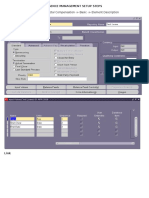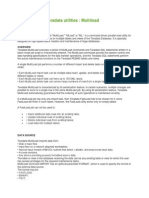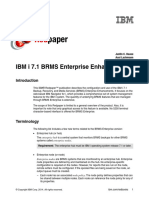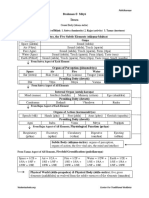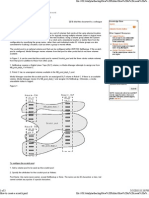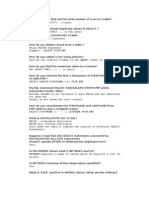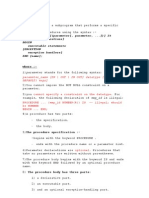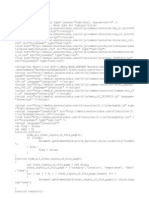Teradata Stored Procedures
Teradata Stored Procedures
Uploaded by
kdtftfjggjyhgCopyright:
Available Formats
Teradata Stored Procedures
Teradata Stored Procedures
Uploaded by
kdtftfjggjyhgOriginal Description:
Copyright
Available Formats
Share this document
Did you find this document useful?
Is this content inappropriate?
Copyright:
Available Formats
Teradata Stored Procedures
Teradata Stored Procedures
Uploaded by
kdtftfjggjyhgCopyright:
Available Formats
Teradata Stored Procedures - Introduction
Stored Procedure is a Teradata object defined in database or user space. Stored Procedure contains two types of statements: SQL statements SPL statements(Stored Procedure Language) Stored Procedures need Perm space. Stored Procedures are compiled, Stored and Executed on the server side. The Source code can also be stored optionally Restrictions on using Stored Procedures: Stored Procedure cannot contain DDL and DCL Statements. Stored Procedure cannot EXPLAIN or USING statements. We can pass parameters to stored procedures. Parameters can be input,output or input/output. The type of parameter is indicated by the wordsIN, OUT or INOUT. IN - Values that are supplied to the stored procedure at execution OUT - Values that are returned from the stored procedure to the user at call completion INOUT - Values that are both supplied to and returned from the stored procedure Stored Procedure can contain up to 1024 parameters.
Example: Creating a simple procedure: CREATE PROCEDURE TEST_PROCS.TEST_PROC ( IN var1 INTEGER, OUT var2 CHAR(40)) --> IN indicates the input parameter, OUT indicates the output parameter. Data types should be provided. BEGIN IF var1 = 0 THEN SET var2 = 'THE VALUE ENTERED IS ZERO'; --> SET is used to assign values to parameters or local variables. Here we set values to an output variable. ELSEIF var1 < 0 THEN SET var2 = 'THE VALUE IS NEGATIVE'; --> SET also ends with a semicolon ELSE --> IF statement may have multiple ELSEIF, but only one ELSE
SET var2 = 'THE VALUE IS POSITIVE'; END IF; --> IF statement must be terminated with END IF END; --> Stored Procedure body is enclosed inside BEGIN and END. END should end with a semi colon. Imp Note: When Using SET to assign values to parameters the Input type parameters(IN) should always be on the right side of = sign (.ie should be the sending fields) and output (OUT) type parameters should always be on the left side of =.(.ie should be receiving fields) If this is not followed we would get an error.
Calling a simple procedure: CALL TEST_PROCS.TEST_PROC(2,variable2) --> All the parameters must be represented in the CALL statement. Note that the output parameter must be specified using the parameter name(variable2 in the example). The Output Parameter value is reported similar to a column value from a table. Result: variable2 THE VALUE IS POSITIVE
Arguments that are passed to the call statement can be defined using constants, variable or both We can call the same procedure as shown in above example as below: CALL SUPPORT_PROCS.TEST_PROC(3*5,Column2) Result: var2 THE VALUE IS POSITIVE CALL SUPPORT_PROCS.TEST_PROC(-2+1,Column2) Result: var2 THE VALUE IS NEGATIVE
You might also like
- Informatica VelocityDocument361 pagesInformatica VelocitynuluparthaNo ratings yet
- Tera Data DOCSDocument92 pagesTera Data DOCSabreddy2003No ratings yet
- BRMSDocument364 pagesBRMSFelix Tan King SengNo ratings yet
- Oracle Absence Management SetupDocument9 pagesOracle Absence Management SetupRavish Kumar SinghNo ratings yet
- Teradata Performance OptimizationDocument7 pagesTeradata Performance OptimizationArjunreddy ShivagariNo ratings yet
- Teradata InternalsDocument21 pagesTeradata Internalsrupesh_bansal5123No ratings yet
- Advanced Teradata ConceptsDocument99 pagesAdvanced Teradata ConceptsCsvv VardhanNo ratings yet
- Comparison of The Teradata Loading UtilitiesDocument4 pagesComparison of The Teradata Loading UtilitiesmohnishNo ratings yet
- Diff. Bet. Theravada & Mahayana BuddhismDocument14 pagesDiff. Bet. Theravada & Mahayana BuddhismlucilleNo ratings yet
- Monitor User Commands:: Examples of 'Who' CommandDocument7 pagesMonitor User Commands:: Examples of 'Who' CommandPavankumar KaredlaNo ratings yet
- Teradata Utilities - 1Document4 pagesTeradata Utilities - 1Nithin MamidalaNo ratings yet
- FTP FAQsDocument7 pagesFTP FAQsMaran GanapathyNo ratings yet
- Teradata Studio FeaturesDocument46 pagesTeradata Studio Featuresprince jainNo ratings yet
- Anas Teradata QuestionsDocument29 pagesAnas Teradata Questionsmadhusudhan reddyNo ratings yet
- Teradata Performance TuningDocument18 pagesTeradata Performance TuningharishkodeNo ratings yet
- TPT Teradata - The Teradata Parallel TransporterDocument6 pagesTPT Teradata - The Teradata Parallel TransportermohnishNo ratings yet
- My Informatica NotesDocument9 pagesMy Informatica Notesakshay_scribdNo ratings yet
- Data Profile DemoDocument8 pagesData Profile Demoapi-26810035No ratings yet
- ISPF EDIT Line CommandsDocument22 pagesISPF EDIT Line CommandsjohnapaceNo ratings yet
- Unix Sample Questions..Document17 pagesUnix Sample Questions..Sai Anil KumarNo ratings yet
- A-Z Performance TuningDocument5 pagesA-Z Performance TuningRajesh RaiNo ratings yet
- 100 Interview Questions Power Bi PDFDocument33 pages100 Interview Questions Power Bi PDFnarendrareddy.biNo ratings yet
- Option 1 Option 2 Option 3 Option 4 Correct AnswerDocument68 pagesOption 1 Option 2 Option 3 Option 4 Correct AnswerSayan GuptaNo ratings yet
- Introduction To Teradata Utilities: MultiloadDocument36 pagesIntroduction To Teradata Utilities: MultiloadkishoreparasaNo ratings yet
- BRMS 7.1 RedbookDocument22 pagesBRMS 7.1 RedbookBoobalan SuppiahNo ratings yet
- PancikaranaDocument1 pagePancikaranamal_sri6798No ratings yet
- TeraData DBADocument7 pagesTeraData DBAavinashkakarlaNo ratings yet
- Basic VI Commands: What Is ?Document6 pagesBasic VI Commands: What Is ?waltert1No ratings yet
- RexxDocument114 pagesRexxapi-3729284No ratings yet
- Teradata UtilitiesDocument88 pagesTeradata Utilitiessiva86No ratings yet
- Unit 1Document219 pagesUnit 1Nitin_Mishra_7014No ratings yet
- Teradata SQL AlchemyDocument199 pagesTeradata SQL AlchemynazmashaiikNo ratings yet
- SQL Interview QuestionsDocument22 pagesSQL Interview QuestionsVarsha Jadwani777No ratings yet
- Netbackup - How To Create A Scratch PoolDocument3 pagesNetbackup - How To Create A Scratch PoolamsreekuNo ratings yet
- ETL Error and Audit Log Process Using ADocument11 pagesETL Error and Audit Log Process Using Akushrajan2No ratings yet
- Unix Basics: TIBCO Software IncDocument34 pagesUnix Basics: TIBCO Software Incswapnil_bankar100% (1)
- Mainframe CommandsDocument5 pagesMainframe CommandsIlyasuddin ShaikhNo ratings yet
- Korn Shell Script WritingDocument87 pagesKorn Shell Script WritingRatna NedunuriNo ratings yet
- SortDocument202 pagesSortAnbazhagan MurugesanNo ratings yet
- Dama Temporal Tables Coffing 201110Document41 pagesDama Temporal Tables Coffing 201110ypswamy3631No ratings yet
- How To Use If in JCLDocument4 pagesHow To Use If in JCLMurali Mohan NNo ratings yet
- COBOL 400: Kishanth Nelson S NDocument49 pagesCOBOL 400: Kishanth Nelson S Nharitha01No ratings yet
- SQL Interview QuestionsDocument12 pagesSQL Interview Questionsapi-20015660100% (1)
- Advanced SQL and PL/SQL Topics: A Guide To Oracle9i 1Document12 pagesAdvanced SQL and PL/SQL Topics: A Guide To Oracle9i 1Ishvinder Singh50% (2)
- How To Write Shell Script: Prev NextDocument92 pagesHow To Write Shell Script: Prev NextDasari Dheeraj ChowdariNo ratings yet
- Teradata Utilities MultiLoadDocument35 pagesTeradata Utilities MultiLoadsaiduluteradataNo ratings yet
- Backup, Recovery, and Media Services For IseriesDocument370 pagesBackup, Recovery, and Media Services For IseriesAndreas Scherer100% (2)
- Talend Tutorial5 Filtering Data Using The TMap ComponentDocument2 pagesTalend Tutorial5 Filtering Data Using The TMap ComponentgeoinsysNo ratings yet
- PROCEDURE Name ( (Parameter (, Parameter, ... ) ) ) IS (Local Declarations) Begin Executable Statements (Exception Exception Handlers) END (Name)Document34 pagesPROCEDURE Name ( (Parameter (, Parameter, ... ) ) ) IS (Local Declarations) Begin Executable Statements (Exception Exception Handlers) END (Name)api-3831209100% (1)
- PLSQL NotesDocument78 pagesPLSQL NotesRaghavendra PrabhuNo ratings yet
- 1 0 Cobol FundaDocument24 pages1 0 Cobol FundasachinkeralaNo ratings yet
- Questions PLSDocument10 pagesQuestions PLSKancharlaNo ratings yet
- PLSQLDocument196 pagesPLSQLanugula ramNo ratings yet
- SQL Scripting & AMDPDocument11 pagesSQL Scripting & AMDPgvrahul100% (1)
- Basic Arduino NotesDocument11 pagesBasic Arduino NotesdanielNo ratings yet
- Stored Procedures: What Is A Stored Procedure?Document5 pagesStored Procedures: What Is A Stored Procedure?ppavandsNo ratings yet
- ProcedureDocument7 pagesProcedureAkshat TarateNo ratings yet
- Exp 5 and 9Document7 pagesExp 5 and 9Godha NemmarugommulaNo ratings yet
- ABAP Join Wizard - ReadMe2Document14 pagesABAP Join Wizard - ReadMe2Anonymous xKZIoAjrlNo ratings yet
- JCLDocument32 pagesJCLKongu Boopathi KumarNo ratings yet
- Triggers in FirebirdDocument7 pagesTriggers in FirebirdDimas AritonaNo ratings yet
- UNIT5Document31 pagesUNIT5youdunomebruh47No ratings yet
- Options Available With NOPIDocument2 pagesOptions Available With NOPIkdtftfjggjyhgNo ratings yet
- Types of Journals in TeradataDocument1 pageTypes of Journals in TeradatakdtftfjggjyhgNo ratings yet
- Blood Group Mobile Number English Dutch: Personal DetailsDocument10 pagesBlood Group Mobile Number English Dutch: Personal DetailskdtftfjggjyhgNo ratings yet
- Set OperatorsDocument3 pagesSet OperatorskdtftfjggjyhgNo ratings yet
- What Is Difference Between TIME and CURRENTDocument1 pageWhat Is Difference Between TIME and CURRENTkdtftfjggjyhgNo ratings yet
- Differences Between Stored Procedure and FunctionDocument1 pageDifferences Between Stored Procedure and FunctionkdtftfjggjyhgNo ratings yet
- Table SQL DataDocument1 pageTable SQL DatakdtftfjggjyhgNo ratings yet
- OracleDocument1 pageOraclekdtftfjggjyhgNo ratings yet
- Basic Shell Scripting Interview Questions and AnswersDocument1 pageBasic Shell Scripting Interview Questions and AnswersKarthikReNo ratings yet
- Unix Interview Questions Leave A CommentDocument6 pagesUnix Interview Questions Leave A CommentkdtftfjggjyhgNo ratings yet
- Shell Scripting Interview Questions and AnswersDocument7 pagesShell Scripting Interview Questions and AnswerskdtftfjggjyhgNo ratings yet
- What Is Bitmap Index Why It's Used For DWH?Document2 pagesWhat Is Bitmap Index Why It's Used For DWH?kdtftfjggjyhgNo ratings yet
- Programme SpecificationDocument8 pagesProgramme SpecificationJoona JohnNo ratings yet
- InstallDocument5 pagesInstallMike KiskeNo ratings yet
- MP QuestionsDocument11 pagesMP QuestionsSwetha RamNo ratings yet
- AN100.EN002 The Circuit Supervision For VAMP40 VAMP130 VAMP135 VAMP140 and VAMP150Document144 pagesAN100.EN002 The Circuit Supervision For VAMP40 VAMP130 VAMP135 VAMP140 and VAMP150Razvan MaresNo ratings yet
- Pm1Ac: General CatalogueDocument1 pagePm1Ac: General CatalogueJulio Alberto VásquezNo ratings yet
- Commonly Used JDBC Class MethodsDocument2 pagesCommonly Used JDBC Class Methodskewan22win_728961021No ratings yet
- Data Mining NotesDocument178 pagesData Mining NotesSangeetha Bajanthri100% (1)
- Albrt931002 SpecDocument148 pagesAlbrt931002 SpecArturo Treviño MedinaNo ratings yet
- CON9714 - de Gruyter-CON9714 - Oracle Management Cloud Best Practices For Mining Oracle Enterprise Manager DataDocument42 pagesCON9714 - de Gruyter-CON9714 - Oracle Management Cloud Best Practices For Mining Oracle Enterprise Manager DatasbabuindNo ratings yet
- Eaton Certificate PolicyDocument33 pagesEaton Certificate PolicyAl MullenNo ratings yet
- Ict SyllabusDocument47 pagesIct SyllabusJoshua NadaNo ratings yet
- CS302 Design and Analysis of Algorithms: Muhammad Sohail AfzalDocument12 pagesCS302 Design and Analysis of Algorithms: Muhammad Sohail AfzalSyeda mahnoorNo ratings yet
- 1Document61 pages1pradheepvijaiNo ratings yet
- WWW - Syncmaroute.ca WWW - Ford.ca: Learn How..Document71 pagesWWW - Syncmaroute.ca WWW - Ford.ca: Learn How..Javier VelascoNo ratings yet
- Typhoon Crisis Mapping With OpenStreetMap, With Harry WoodDocument27 pagesTyphoon Crisis Mapping With OpenStreetMap, With Harry WoodOpen Data InstituteNo ratings yet
- Yammer Use Case CatalogDocument29 pagesYammer Use Case Catalogshar.rajeshkNo ratings yet
- 4th International Conference On Recent Trends in Computer Science and ElectronicsDocument118 pages4th International Conference On Recent Trends in Computer Science and ElectronicsAnchal SinghNo ratings yet
- RA-IMS Booklet PDFDocument2 pagesRA-IMS Booklet PDFPadma ShahiNo ratings yet
- Abstract On Cloud ComputingDocument1 pageAbstract On Cloud ComputingsudheerboganiNo ratings yet
- Chapter 5 QS015 2017 18 Nota Pelajar 1Document220 pagesChapter 5 QS015 2017 18 Nota Pelajar 1Ahmad MutqmaNo ratings yet
- Apple Cjenovnik Juni 2013Document8 pagesApple Cjenovnik Juni 2013BarrneyNo ratings yet
- ATS 48 Modbus ProtocolDocument6 pagesATS 48 Modbus ProtocolMohamed ElbanadiNo ratings yet
- javaDocument9 pagesjavaDipali YadavNo ratings yet
- Formula SheetDocument63 pagesFormula SheetNitish NaglakshNo ratings yet
- Week2 - Lesson 2. Basics of Work Breakdown Structure (WBS)Document11 pagesWeek2 - Lesson 2. Basics of Work Breakdown Structure (WBS)manorajcvNo ratings yet
- Storage SystemsDocument12 pagesStorage SystemsEdu MansibangNo ratings yet
- IBM System x3650 M3, 7945K1G - 7945K1GDocument3 pagesIBM System x3650 M3, 7945K1G - 7945K1GAdalberto BarbosaNo ratings yet
- DmallocDocument60 pagesDmallocbojke2000No ratings yet



